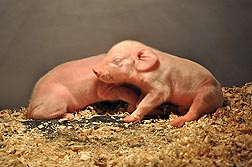This page has been archived and is being provided for reference purposes only. The page is no longer being updated, and therefore, links on the page may be invalid.
| Read the magazine story to find out more. |
|
|
|
|
Tiny Doses of Bile Acid May Blunt Preemie Liver Disease
By Marcia WoodJune 13, 2013
Giving premature babies small doses of a bile acid might help the newborns avoid a liver disease, according to U.S. Department of Agriculture (USDA) physiologist Douglas G. Burrin and his colleagues.
In a preliminary study with newborn piglets as the animal model, Burrin and his co-investigators showed that the bile acid CDCA (chenodeoxycholic acid) helped combat parenteral nutrition-associated liver disease (PNALD), a liver condition that sometimes occurs in preemies nourished exclusively through intravenous feeding.
Known as total parenteral nutrition, or TPN, this feeding regimen can save lives but, if administered for longer than two weeks, may lead to complications such as PNALD.
There is no well-established, science-based cure for PNALD. In severe cases, PNALD can lead to liver failure and the need for a liver transplant.
In ongoing research designed to prevent or minimize the impact of PNALD and other unwanted side effects of TPN, Burrin and colleagues showed that administering small doses of CDCA three times a day helped fight PNALD in TPN-fed piglets. The team based its conclusion on measurements of three key biomarkers: serum bilirubin, serum bile acids, and liver triglycerides.
Published in a 2012 issue of the American Journal of Physiology—Gastrointestinal and Liver Physiology, the study is the first to demonstrate the use of CDCA, delivered directly to the upper digestive tract, to control PNALD in a newborn lab animal model.
Piglets were chosen for this research because the pig digestive tract is very similar to that of humans. In addition, the size and body composition—the amount of fat and lean—in an infant piglet is typically comparable to that of a human preemie.
Burrin is with USDA's Agricultural Research Service (ARS) and is based at the Children's Nutrition Research Center in Houston, Texas. He collaborated in the study with nutrition center co-researchers David D. Moore and Barbara Stoll; Ajay Kumar Jain, formerly with the research center; and Jens J. Holst of the University of Copenhagen, Denmark.
Baylor College of Medicine, Texas Children's Hospital and ARS jointly manage the nutrition research center. ARS is the USDA's chief intramural scientific research agency, and this research supports the USDA priority of improving children's health and nutrition.
Read more about this research in the May/June 2013 issue of Agricultural Research magazine.

